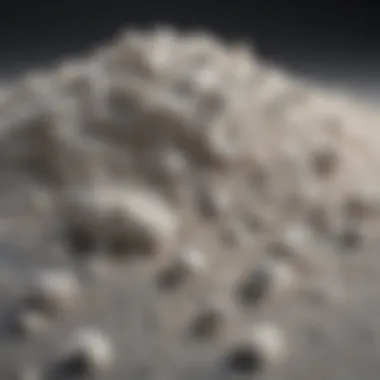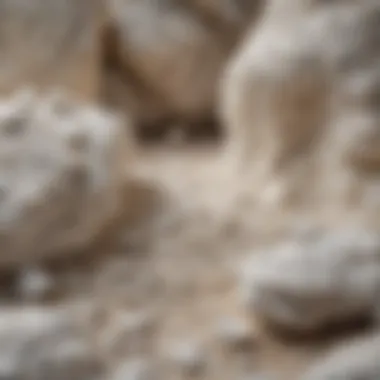Unveiling the Enigmatic Essence of White Talc Powder


Rock and Fossil Identification
White talc powder, although not a rock or fossil in its traditional form, exhibits characteristics that mirror those of geological specimens. Its unique properties, such as a greasy feel and pearly luster, set it apart from other minerals. While it might not fit the typical criteria for rock and fossil identification, understanding its composition and appearance can deepen our appreciation for the natural world.
Geological Insights
Exploring white talc powder unveils insights into geological formations and processes that contribute to its creation. Originating from the alteration of magnesium-rich rocks, talc forms in diverse environments through metamorphic processes. This mineral holds historical significance, with notable discoveries revealing its presence in ancient cosmetic and industrial applications. By delving into the geological context of white talc powder, a richer understanding of its role in the Earth's history emerges.
Introduction to White Talc Powder
White talc powder, a mineral marvel revered for its versatile properties, serves as the focal point of this intricate exploration. As we embark on a journey through the realms of talc, we uncover the essence of its composition, historical eminence, and its ubiquitous presence in various industrial sectors. The introduction sets the stage for a comprehensive elucidation of white talc powder's significance in shaping both the past and the future landscape of multiple industries.
Understanding the Composition of Talc
The Mineral Structure of Talc
Delving into the intricate mineral structure of talc unveils a mesmerizing arrangement characterized by its softness and pliability. This unique feature stems from the mineral's composition of hydrated magnesium silicate, showcasing a layered structure that imparts talc with its exceptional smoothness and lubricating properties. This innate quality elevates talc to a coveted choice for industries seeking materials with low abrasiveness and high chemical resistance, making it an indispensable component in various applications.
The Geological Formation Process of Talc Deposits
Embarking on a geological expedition into the formation process of talc deposits unveils a fascinating narrative of metamorphism and hydrothermal alteration. Talc deposits originate from the alteration of magnesium-rich rocks under low-grade metamorphic conditions, culminating in the emergence of this mineral wealth. The geological genesis of talc deposits not only provides insights into the Earth's dynamic processes but also underscores the geological significance of talc as a mineral resource, shaping its widespread availability and accessibility.
White Talc Powder: Definition and Characteristics


The Purity Levels of White Talc Powder
Analyzing the purity levels of white talc powder illuminates a spectrum of grades ranging from cosmetic to pharmaceutical standards. The purity of white talc powder is a defining feature that influences its appropriateness for diverse applications, ensuring compliance with stringent quality benchmarks. This nuanced characteristic underscores the versatility of white talc powder, catering to the distinct requirements of industries seeking premium-grade materials for their formulations.
Physical Properties of White Talc Powder
Exploring the physical properties of white talc powder unveils a trove of exceptional attributes that distinguish it from conventional minerals. With its unmatched softness, opacity, and lubricity, white talc powder emerges as a prized ingredient in industries valuing tactile elegance and structural integrity. The cohesive nature of its particles, coupled with its unparalleled whiteness, positions white talc powder as a premier choice for applications demanding precision, consistency, and aesthetic finesse.
Historical Significance of White Talc
Ancient Uses of Talc Powder
Tracing the historical trajectory of talc reveals ancient civilizations harnessing its talismanic properties for ritualistic and cosmetic purposes. From adorning the elite in powdered luxury to intricate religious practices, talc powder symbolized purity and prosperity throughout antiquity. Its enduring legacy as a symbol of refinement underscores its enduring allure across cultures and epochs, transcending time to impart beauty and prestige.
Evolution of Talc Applications Over Time
Witnessing the evolution of talc applications chronicles a transformative journey from sacred rituals to modern-day industrial innovations. The adaptability of talc across industries, from cosmetics to ceramics, signifies its seamless integration into the fabric of societal progress. The metamorphosis of talc from a symbol of luxury to a cornerstone of industrial applications symbolizes its enduring relevance and versatility in shaping the course of human ingenuity and advancement.
Industrial Applications of White Talc Powder
In the realm of white talc powder, its industrial applications serve as a cornerstone in various sectors, playing a pivotal role in shaping multiple industries. The significance of industrial applications of white talc powder lies in its versatile nature and unique properties that set it apart from other minerals. From enhancing product quality to improving processing efficiency, white talc powder proves to be an indispensable ingredient in the manufacturing world. This section will delve into specific elements such as the benefits, considerations, and impact of industrial applications of white talc powder, providing a thorough exploration of its essential role in different industries.
Cosmetic and Skincare Industry


Role of Talc in Cosmetics
The role of talc in cosmetics is multifaceted, with its primary function being that of an excellent absorbent and mattifying agent. Its ability to absorb moisture and oil makes it a popular choice for cosmetic formulations, especially in products like powders, foundations, and blushes. The finely milled texture of talc enables a smooth and velvety application, imparting a luxurious feel to cosmetic products. While talc's oil-absorbing properties make it beneficial for controlling shine and prolonging makeup wear, its neutral color ensures seamless blending with various skin tones. However, concerns about talc's potential link to health risks, specifically in talcum powder, have prompted manufacturers to introduce talc-free alternatives to cater to a more health-conscious consumer base.
Innovative Uses in Skincare Products
In skincare products, talc has found innovative applications beyond its traditional role in cosmetics. Its gentle nature makes it suitable for sensitive skin formulations, where it functions as a bulking and texturizing agent. Talc's softening properties contribute to the spreadability and comfort of skincare products, enhancing their overall sensory experience. Moreover, talc's opacity can help in diffusing light, blurring imperfections, and creating a smooth base for skincare treatments. Despite its proven efficacy, some concerns regarding talc contamination with asbestos have led to increased scrutiny and rigorous testing protocols within the skincare industry to ensure product safety and consumer confidence.
Environmental and Health Considerations
In the context of this article dissecting the wonders of white talc powder, delving into the environmental and health considerations associated with its extraction and utilization is crucial. The intricate interplay between human interventions and ecological sustainability underpins the relevance of scrutinizing the impacts of talc mining on both nature and public well-being. Understanding the broader ramifications of talc production is imperative for fostering responsible practices and fostering a harmonious coexistence between industry advancements and environmental stewardship.
Ecological Impact of Talc Mining
Effects on Local Ecosystems
Exploring the effects of talc mining on local ecosystems unravels a complex web of interactions between mineral extraction activities and delicate natural habitats. The disturbance caused by mining operations often leads to habitat fragmentation, soil erosion, and alteration of water bodies, impacting wildlife populations and plant biodiversity. The consequential loss of biodiversity and disruptions in ecosystem dynamics underscore the significant repercussions of talc mining on local flora and fauna. Balancing the economic benefits of talc extraction with the imperative of preserving fragile ecosystems poses a pivotal challenge in sustainable resource management.
Sustainability Practices in Talc Extraction
Analyzing sustainability practices in talc extraction sheds light on the industry's efforts to mitigate environmental footprints and embrace ecologically conscious methodologies. Implementing strategies like reclamation of mined lands, water conservation, and energy-efficient processes are cornerstones of sustainable talc mining practices. Embracing transparency, accountability, and engagement with local communities in extraction activities are pivotal in upholding responsible mining practices. Striking a balance between economic viability and environmental stewardship is central to ensuring the long-term sustainability of talc mining operations.
Health Concerns Surrounding Talcum Powder


Debates on Talc-Related Health Risks
Unraveling the debates surrounding talc-related health risks underscores the importance of critically assessing the potential health implications associated with talcum powder usage. Controversies regarding talc's link to respiratory concerns, skin irritations, and even cancer have sparked widespread discourse within medical and consumer advocacy realms. Disentangling the scientific evidence from anecdotal claims is essential in formulating informed judgments on talc-related health risks.
Regulatory Measures and Consumer Awareness
Navigating the landscape of regulatory measures and consumer awareness surrounding talcum powder underscores the regulatory frameworks in place to safeguard public health and promote product transparency. Monitoring talc-containing products, implementing quality control measures, and enhancing consumer education on product usage are critical components in mitigating health risks associated with talcum powder. Striking a delicate balance between regulatory enforcement and consumer empowerment is paramount in cultivating a culture of safety and informed decision-making within the beauty and personal care industries.
Future Trends and Innovations in Talc Industry
In the realm of white talc powder exploration, delving into the sphere of future trends and innovations in the talc industry holds paramount importance. As we navigate through the dynamic landscape of industrial advancements, it is crucial to anticipate the trajectory of talc processing methods and product development. Understanding the evolving trends and innovative practices in the talc industry not only showcases the adaptability of this mineral but also underscores its enduring relevance across diverse sectors. Highlighting the nuances of technological advancements and research initiatives sheds light on the progressive nature of talc utilization and its pivotal role in industrial evolution.
Technological Advancements in Talc Processing
Efficiency improvements in talc extraction
Efficiency improvements in talc extraction mark a pivotal aspect in revolutionizing the mining and processing of talc. By optimizing extraction methods, the industry enhances productivity while minimizing resource wastage. The key characteristic of efficiency improvements lies in streamlining operations to achieve higher yield rates and operational cost-effectiveness. This proactive approach not only boosts profitability for companies but also promotes sustainable mining practices conducive to environmental preservation. The unique feature of enhancing efficiency in extraction is its ripple effect on overall supply chain management and product quality, making it a strategic and prudent choice for sustainable talc production.
Innovative applications in emerging industries
The innovative applications of talc in emerging industries signify a shift towards diversification and expanded utility beyond traditional sectors. By embracing novel avenues such as advanced materials, nanotechnology, and biomedicine, talc demonstrates its intrinsic versatility and adaptability. The key characteristic of innovative applications lies in driving exploration towards untapped markets and interdisciplinary collaborations, fostering a culture of creativity and transformation in the industrial landscape. This strategic evolution showcases talc's potential to revolutionize diverse sectors and catalyze groundbreaking solutions through interdisciplinary synergy. The unique feature of pioneering innovative applications is its capacity to spark market interest, catalyze consumer demand, and redefine the narrative of talc powder from a conventional ingredient to a cutting-edge material across multiple burgeoning industries.
Research and Development in Talc-Based Products
Exploring new uses of white talc powder
The exploration of new applications for white talc powder signifies a continuous quest towards unlocking its latent potential and expanding its repertoire of uses across various domains. By venturing into uncharted territories and interdisciplinary collaborations, researchers push the boundaries of talc utilization beyond conventional norms. The key characteristic of this exploration lies in diversifying talc's application spectrum and uncovering innovative solutions to contemporary challenges in industries ranging from cosmetics to renewable energy. This pioneering spirit not only underscores the adaptive nature of talc but also propels creation, innovation, and sustainability across industrial verticals. The unique feature of exploring new uses of white talc powder is its transformative impact on elevating industry standards, fostering competitive differentiation, and opening avenues for novel product development and commercialization.
Sustainable practices in talc production
Embracing sustainable practices in talc production represents a shift towards ethical mining, environmentally conscious manufacturing, and socially responsible supply chain management within the talc industry. By prioritizing ecosystem preservation, reduction of carbon footprint, and adoption of eco-friendly methodologies, companies uphold principles of sustainability and corporate social responsibility. The key characteristic of sustainable practices lies in fostering a symbiotic relationship between environmental stewardship and industrial progress, balancing resource extraction with conservation imperatives. This holistic approach not only safeguards natural habitats and biodiversity but also positions talc production as a beacon of sustainable industrial practices within the global market. The unique feature of implementing sustainable practices in talc production is its potential to resonate with environmentally conscious consumers, garner industry recognition, and drive positive change towards a greener and more sustainable future.







